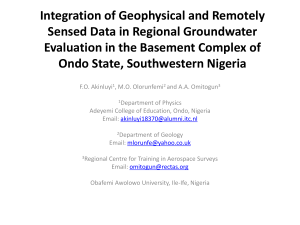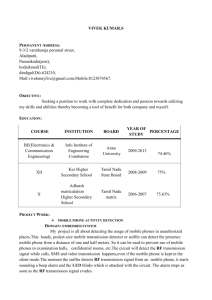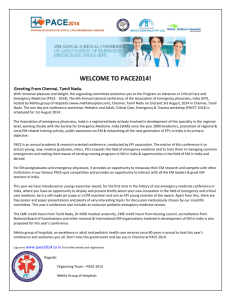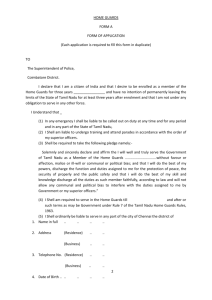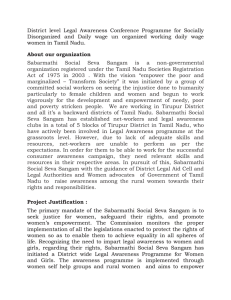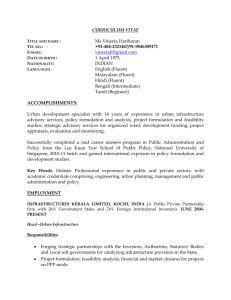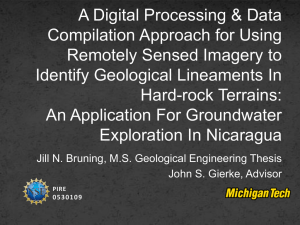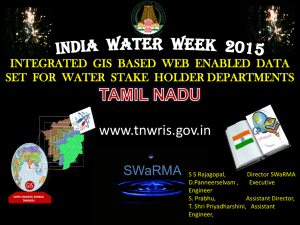A palaeostress analysis of Precambrian granulite terrain of northern
advertisement
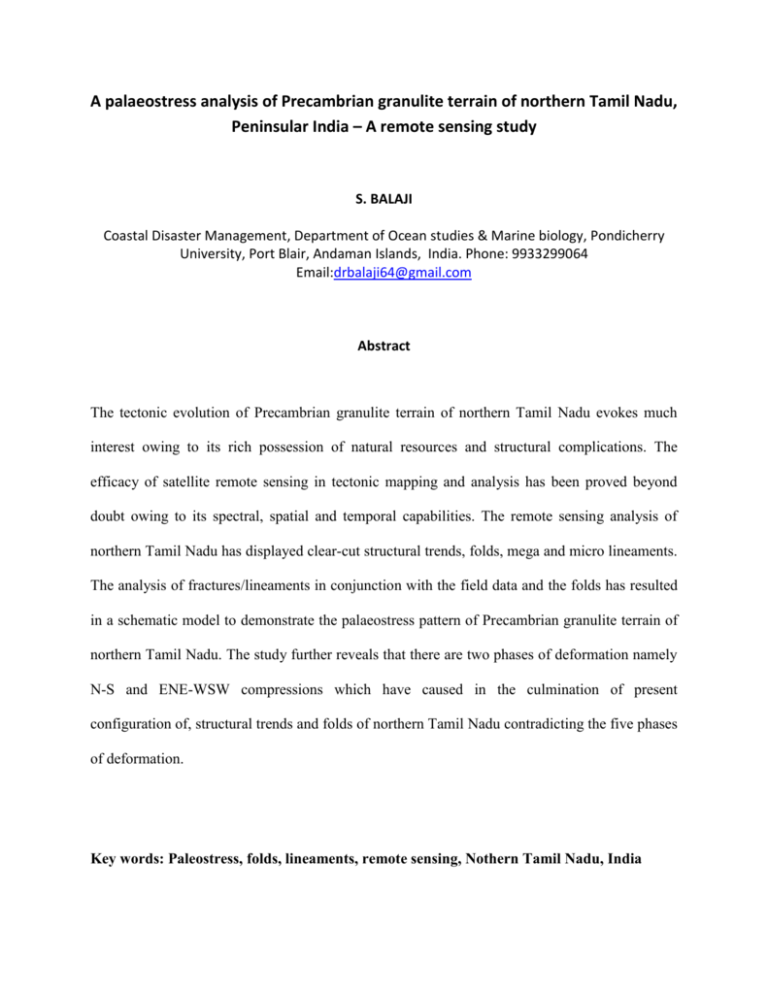
A palaeostress analysis of Precambrian granulite terrain of northern Tamil Nadu, Peninsular India – A remote sensing study S. BALAJI Coastal Disaster Management, Department of Ocean studies & Marine biology, Pondicherry University, Port Blair, Andaman Islands, India. Phone: 9933299064 Email:drbalaji64@gmail.com Abstract The tectonic evolution of Precambrian granulite terrain of northern Tamil Nadu evokes much interest owing to its rich possession of natural resources and structural complications. The efficacy of satellite remote sensing in tectonic mapping and analysis has been proved beyond doubt owing to its spectral, spatial and temporal capabilities. The remote sensing analysis of northern Tamil Nadu has displayed clear-cut structural trends, folds, mega and micro lineaments. The analysis of fractures/lineaments in conjunction with the field data and the folds has resulted in a schematic model to demonstrate the palaeostress pattern of Precambrian granulite terrain of northern Tamil Nadu. The study further reveals that there are two phases of deformation namely N-S and ENE-WSW compressions which have caused in the culmination of present configuration of, structural trends and folds of northern Tamil Nadu contradicting the five phases of deformation. Key words: Paleostress, folds, lineaments, remote sensing, Nothern Tamil Nadu, India 1.Introduction The understanding of structure and tectonics in an area is important as it sheds light on the magmatism, metallogeny, ground water, seismicity and geothermal resources. The Precambrian-Archaean rocks of Peninsular India exhibit polyphase metamorphism, multiple deformation, repetitive folding and intense fracturing. These highly fragmented and widely disseminated rock types show contrasting fold styles, multi variate linear and planar features. These linear and planar features have controlled localization of minerals, ore bodies and ultrabasics at several places. In addition, the linear features control major rivers like Cauvery, Coleroon, Bhavani, Moyyar and reactivate frequently in the form of earth tremors along Precambrian fractures (Balaji, 2000). Narayanaswamy (1966), Grady (1971), Sugavanam et al. (1977), Katz (1978), Drury and Holt (1980), Ramasamy et al. (1987), Naga (1988), Ramasamy and Balaji (1995) and Ramasamy et al. (1999) have studied the regional tectonic analysis of southern Peninsular India. Among these geoscientists, Sugavanam et al. (1977) attributed five phases of deformation and Narayanasamy (1966), Ramadurai et al. (1975), Katz (1978), Naga (1988) and Ramasamy et al. (1999) advocated two phases of deformation responsible for the tectonic evolution of Precambrian fold belts of southern Peninsular India. The northern Tamil Nadu, which is a part of southern Peninsular India wherein tectonic studies were carried out at few places and hence, disseminated information is available. A comprehensive and a wholistic tectonic model for the evolution of Precambrian folds of this region is not available. Hence, the present study has been taken to study all the structural features in detail using satellite imagery amended with ground data and analyse them critically in a regional matrix to bring out a schematic model for the tectonic evolution of Precambrian fold belts of northern Tamil Nadu. 2. Geological setting The northern Tamil Nadu is bounded by northern latitude 10° 49″ 00′ and 13° 00″ 00′; eastern longitude 77° 38″ 00′ and 80° 10″ 00′ which covers an area of nearly 75,000 sq.km encompassing crystalline and sedimentary tracts. But, the present study is focussed on the crystalline tract only (C, figure 1) excluding the sedimentary formations in the east (S, figure 1). The Precambrian granulite terrain comprised of diversified rock types namely charnockites, biotite gneiss, pyroxene granulite, granite, migmatite, granitoid gneiss, syenite and ultrabasics. These rock types are traversed by dolerite and gabbro dykes at several places. Major hillocks are Biligirirangan, Shevroy-Chitteri-Kalrayan and Kolli-Pachai. The Biligirirangan hills occupy the western part (7, figure 1), the Javadi- Shevroy-Chitteri-Kalrayan hills covers the central part (1,2,3 and 4, figure 1) and the Kolli-Pachai hills occur in the southern part of the study area (5 and 6, figure 1) are composed of charnockitic rocks. 3. Methods 3.1 Structural trendline mapping Geological or topographical alignments usually straight and occasionally arcuate which can be recognized on aerial photographs to consistently occur over a wide region. These have been variously named as fracture zone, trendline and tectonic trends (Auden, 1954 and Eremenko 1964). Bedding, foliation and lineation in rocks which are seem to be related to tectonic trends. Drury and Holt (1980) have used Landsat satellite imagery to trace the alignment of geological significance such as planar fabric and steep to vertical compositional layering and they traced the regional scale folds and shears of South India from this. Ramasamy et al. (1987) and Ramasamy et al. (1999) have used Indian Remote Sensing hereinafter called as IRS, 1A satellite imagery to interpret the structural trendline and regional folds of South India. Nair (1990) and Nair and Nair (2001) have interpreted structural trends using IRS 1A satellite imagery based on tonal contrast, tonal linearity and elicited fold features such as F 1, F2 and F3 folds from structural trends. In the present study, the structural features of northern Tamil Nadu were interpreted visually (figures 2, 3, and 4) using, False Colour Composite hereinafter called FCC, Linear Imaging Self Scanning hereinafter called LISS 1 satellite data of 1987 on 1:250,000 scale on individual scene by adopting the same methodology of Auden (1954), Eremenko (1964), Drury and Holt (1980), Ramasamy et al. (1987), Nair (1990), Ramasamy et al. (1999) and Nair and Nair (2001). The whole area is covered in eight individual scenes. Landsat satellite imagery Thematic Mapper (TM), band 6 data was used on 1:250,000 scale for thick soil covered area. The interpreted each scene data were mosaiced on a planimetrically controlled map which resulted in composite regional structural trendline pattern of northern Tamil Nadu. The attitude of the beds measured in the field were incorporated in structural trends. The fold styles were then determined from structural trendlines (Ramasamy et al. 1987), Nair (1990) and Ramasamy et al. 1999) and based on the fold style pattern, different structural domains were classified (Fig.5). 3.2 Lineament mapping O’Leary et al. (1976) defined the term lineaments as mappable, simple or composite linear feature of a surface, whose parts are aligned in a rectilinear or slightly curvilinear relationship and which differs distinctly from the pattern of adjacent features and presumably reflects a subsurface phenomenon. The lineaments were interpreted visually using IRS 1A, LISS 1, FCC satellite data of 1987 on 1:250,000 scale on several individual scene, based on the morphological expression and anomalies such as straight sharp linear ridges, lithological straightness, sharp lithological contact, offset of lithologies and structures identified by zones of block displacements and truncation of structures along major faults (Brockmann et al. 1977), long and linear fracture valley, soil tone linearities, vegetational alignment (figure 3) and straight/ rectilinear drainages (figure 4 and Haman 1961, Bakliwal 1978, Ramasamy and Balaji 1993, Ramasamy and Balaji 1995 and Ramasamy et al. 1999). The whole study area is covered in eight scenes and the interpreted eight scenes were mosaiced on a planimetrically controlled map to get the composite regional lineament pattern of northern Tamil Nadu. The lineaments falling in different structural domains were filtered separately and the lineament density map (Fig. 6) was prepared by gridding each domain into 2.5 sq.cm grid (which is equal to 6.25 sq.km / grid on the ground). The total length of the lineaments falling in each grid area was measured, plotted in the centre of the grid and contoured (Fig.6). The fold styles in conjunction with the lineaments in each domain were critically analysed. Domainwise stress pattern and regional stress pattern of northern Tamil Nadu were identified and finally, a schematic tectonic model was built in. 4. Structural analysis of satellite imagery 4.1 Structural trends The interpretation of structural trends using satellite imagery is already dealt with in section 3.1 and the structural trends of northern Tamil Nadu are shown in figure 1. These structural trends have followed the regional trend of Eastern Ghats hill ranges. The structural trends fell in five azimuthal frequencies viz N-S, NNE-SSW, NE-SW, E-W and NNW-SSE directions. The structural trends show; Long and linear N-S trending structural trend with dips 30° – 70° towards the east in Biligirirangan area NNE-SSW trending long, linear, broad, open, circular structural trends in Javadi-Kalrayan area with dips 40° - 80° towards the east N-S to NE-SW trending structural trends in Madras area with dips 45° - 60° towards the east and Circular, ovoidal, broad open structural trends in Kolli-Pachai area (Balaji, 1995 and 1996) 4.2 Fold styles and structural domains Subsequent to the preparation of the structural trendline map of the study area, the types of folding were deduced; by analyzing the pattern and distribution of structural trends through the integration of structural trends and drainage through the integration of structural trends with the orientation of shadows and highlights. For example, dip slope side of beds are relatively broad and bright displayed in imagery and on the other hand, on the antidip scarp sides opposite to dipping side, narrow and dark shadow appear in imagery because of low sun angle and through the integration of structural trends with field strike/dip data The types of folding and the position of fold axes were determined for all the structures in the study area. The fold styles and fold axes so identified indicated the following characteristics in each region (figure 5); in Biligirirangan region, the folds are mostly tight, long, linear, overturned with N-S trending axial traces and the folds are of alternating anticlines and synclines the existence of long and upright open, isoclinals folds with NNW-SSE to NE-SW trending axial traces in Javadi-Chitteri-Kalrayan region broad open, elliptical doubly plunging domes and basin in Chengam-Madras region with NE-SW trending axes and the existence of domes and basins, upright anticlines and synclines in Kolli-Pachai hills with NE-SW trending axis east of Namakkal, E-W trending axial traces in the centre and WNW-ESE trending axial traces west of Namakkal area. Based on the pattern of fold styles and fold axes, four structural domains have been demarcated (1, 2, 3 and 4, figure 5). They are as follows and their characteristics were already discussed as above. Biligirirangan domain Javadi-Kalrayan domain Madras domain and Kolli-Pachai domain 4.3 Lineaments The lineaments of any region in general control minerals, ground water, ore bodies and ultrabasics. The interpretation of lineaments using satellite imagery is dealt with in section 3.2. The interpreted lineaments fell in six azimuthal frequencies namely NE-SW, NW-SE, N-S, E-W, ENE-WSW and WNW-ESE directions. These Precambrian lineaments were deep seated (Grady 1971) and analysed for domainwise stress pattern. Bakliwal (1978) and Ramasamy and Bakliwal (1988) have computed palaeostress for the tectonic evolution of folds in quartzites of Rajasthan and Vindhyan basin of Rajasthan respectively from lineament density map. In the present study, the interpreted lineaments were filtered for each domain separately and analysed statistically from lineament density contours (Fig.6). 4.4 Lineament density The preparation of lineament density contours was already discussed in section 3.2 and was prepared for all the four structural domains. The lineament density contours of Biligirirangan domain are in circular and elliptical shapes which varied from 2 to 8 km per unit area (figure 6). From the lineament density contours and along the crest of lineament density maxima contours, the lineament density maxima axes were drawn (figure 7). Similarly, along the crest of such lineament density minima contours, the lineament density minima axes were drawn (figure 7). The lineament density maxima axes indicated the axes of maximum strain and lineament density minima axes indicated the minimum strain (Bakliwal 1978 and Ramasamy and Bakliwal 1988). In a similar manner, the lineament density contours for Javadi-Kalrayan, Madras and Kolli-Pachai hill domains were drawn and the axes of lineament density maxima and minima were derived for these domains (figure 8). 5. Discussion Domainwise stress analysis was done for all the four structural domains namely Biligirirangan, Javadi-Chitteri, Madras and Kolli-Pachai domains. The axial traces of folds in conjunction with the lineament density of each structural domain were scrutinized in detail to identify the stress pattern in each domain separately. Accordingly, from principal elongation of folds and lineament density contours, greatest principal stress for each structural domain was derived (figure 8). The general axial traces of folds in Biligirirangan domain was observed in NNE-SSW direction (figure 8). The greatest stress computed from the bulk strain or principal elongation of folds (Hobbs et al. 1976) fell in N80°W –S80°E directions. But, the lineament maxima/strain maxima axes fell in NE-SW, and WNW-ESE directions which are the Precambrian dextral and sinistral faults respectively (Balaji, 1995) and hence, the greatest principal stress is conceived in ENE-WSW direction along the acute bisector (Anderson, 1951) of these two Precambrian faults. The folds in Biligirirangan domain are flexural slip folds (Balaji 1995) and the bulk strain varies from place to place because of the adjustment of the folds with the basement configuration. The greatest principal stress deduced from the bulk strain is considered as a local phenomenon but the greatest principal stress deduced from the lineament anomaly axes remain the same in the entire Biligirirangan domain and therefore the greatest principal stress deduced from the lineament anomaly axes trending in ENE-WSW direction is taken as the stress pattern for Biligirirangan domain (figure 8). In Javadi-Kalrayan domain, the axial traces of folds were trending in N-S direction (figure 8) and hence, the greatest principal stress conceived from folds is in E-W direction. In the eastern part of the same domain, the greatest principal stress is directed in WNW-ESE direction and hence, the bulk strain varies from place to place within the domain. But, the lineament anomaly axes are same in the entire domain and aligned in ENE-WSW direction (figure 9) which is the acute bisector of NE-SW trending Precambrian dextral and WNW-ESE trending sinistral faults. In Madras domain, the fold axes are trending in N-S in the northern part, NE-SW in the central part and ENE-WSW in the southern part of the domain (figure 8) and these folds were demonstrated to be flexuralslip folds (Balaji 1995). So, on the basis of principal finite elongation of folds or bulk strain, the greatest principal stresses vary from place to place within the domain in E-W direction in the northern part, NW-SE direction in the central part and NNW-SSE direction in the southern part of the domain. But, the lineament anomaly axes are not varying in the entire domain and maintain the same direction throughout the domain i.e in ENE-WSW direction (figure 8). In Kolli-Pachai domain, the axes of folds are in NE-SW direction in Manmedu, N-S direction south of Namakkal and NW-SE direction north of Namakkal but the greatest principal stress deduced from the lineament anomaly axes is not varying but trending in ENE-WSW direction which is the acute bisector of NE-SW trending Precambrian dextral and WNW-ESE trending sinistral faults. The overall stress pattern for the entire northern Tamil Nadu deduced from the bulk strain or the principal stresses deduced from bulk strain vary from place to place in all the structural domains and is greately constrained by shallow and basement irregularities. The greatest principal stresses deduced from the lineament anomaly axes do not vary in all the structural domain and maintain the uniformity throughout the entire northern Tamil Nadu of Peninsular India (figures 7, 8 and 9). The greatest principal stress derived from the lineament anomaly axes directed in ENE-WSW trending Precambrian dextral faults is taken as the regional stress pattern to cause the tectonic evolution of folds of northern Tamil Nadu (Figure 9). Sugavanam et al. (1977) was of the opinion that Archaean-Precambrian piles of southern Peninsular India have undergone five phases of deformation. Narayanasamy (1966), Ramadurai et al. (1975), Katz (1978), Naga (1988) and Ramasamy et al. (1999) have suggested two episodes of deformation for the tectonic evolution of folds of southern Peninsular India. The newly presented tectonic model for northern Tamil Nadu, which is a part of southern Indian Peninsula (figure 9) provided more evidence and supports the theory of two episodes of deformation as postulated by (Ramasamy et al. 1999) for the tectonic evolution of whole of southern Indian Peninsula. 6. Conclusion The tectonic evolution of Precambrian granulite terrain of northern Tamil Nadu is therefore attributed to two episodes of deformation. First compression is in N-S direction which has caused cymatogenic arches and deeps from Cape-Comorin in the southern India upto the Himalayas in the north (Ramasamy and Balaji 1995) and the second, most violent compression trends in ENE-WSW direction, are responsible for the tectonic evolution of Precambrian fold belts of northern Tamil Nadu. Acknowledgement The author is thankful to Prof.SM. Ramasamy, Vice-Chancellor, Gandhigram Central University, Dindigul, India for his valuable guidance and suggestions. Reference Anderson, E.M., 1951, The dynamics of faulting and dyke formation with application to Britain. Oliver and Boyd, London. Auden, J.B., 1954, Erosional pattern and fracture zone in Peninsular India. Geol. Mag.,91, 89-101. Bakliwal, P.C., 1978, Tectonic interpretation from lineament analysis using photogeophysical techniques of Ranthamber fort areas, Rajasthan, India. Third regional conference on Geology and mineral resource of Southeast Asia, 129-131. Balaji, S., 1995, Structure and tectonics of northern Tamil Nadu, India through integrated remote sensing. Ph.D thesis submitted to Bharthidasan University, 177p. Balaji, S., 1996, Structural trends and fold styles of northern Tamil Nadu, Jour.Geosci.Develop., 40-41. Balaji, S., 2000, Seismic prone lineaments of Tamil Nadu, India and its impact on environment through remote Sensing. International Archives of Photogrammetry and Remote Sensing. 33(7), 101-105. Brockmann, C.E., Alvaro fernandez, Raul ballon and Hernan claure, 1977, Analysis of geological structures based on Landsat 1 images. In Remote Sensing applications for mineral exploration, edited by William L. Smith, 292-317. Drury, S.A., and Holt, R.W., 1980, The tectonic framework of South Indian Craton; A reconnaissance involving Landsat imagery. Tectanophysics, 65, T1-T15. Eremenko, N.A., 1964, Oil and gas possibilities of West Bengal. Bull. O.N.G.C 1, 1-25. Grady, J.C., 1971, Deep main faults in South India. Jour.Geol.Soc.Ind. 12(1), 56-62. Haman, P.J., 1961, Lineament analysis on aerial photographs exemplified in the north surgeon lake area, Alberta. West Canadian Research Publications in Geology and related science series, 1, 1-20. Hobbs, B.E., Means, W.D., and Williams, P.F., 1976, An outline of structural geology, John Wiley and Sons, New York. Katz, M.B., 1978, Tectonic evolution of Archaean granulite facies belts of Srilanka-South India. Jour.Geol.Soc.Ind. 19(5), 185-205. Naga, K., 1988, Structural relations of charnockites of south India. Proceedings on workshop on the deep continental crust of South India, 99-100. Nair, M.M., 1990, Structural trendline pattern and lineaments of the Western Ghats, South of 13° latitude. Jour.Geol.Soc.Ind, 35, 99-105. Nair, M.M., and Nair, R.V.G., 2001, Strategies for gold exploration in virgin high grade terrains of Attapady valley, Kerala. Jour.Geol.Surv.Ind.Spl.Pub.No.58, 181-190. Narayanaswami, S., 1966, Cross-folding and en-echelon folding in Precambrian rocks of India and their relation to metallogenesis. Jour.Geol.Soc.Ind.1, 80-104. O’leary, D.W., Friedman, J.D., and Pohn, H. A., 1976, Lineament, linear, lineation: Some proposed new standards of old terms. Geol.Soc.Ameri.Bull. 87, 1463-1469. Ramasamy, SM., Panchanathan, S., and Palanivel, R. (1987). Pleistocene earth movements in Peninsular India evidences from Landsat MSS and Thematic mapper data. Proceedings on International Geoscience and remote sensing symposium, Michigan, 1157-1161. Ramasamy, SM., and Balaji, S., 1993, Aid of remote sensing and Pleistocene tectonics of southern Indian Peninsula. Internat.Jour.Rem.Sen. 16(13), 2375-2391. Ramasamy, SM., and Balaji, S., 1995, Remote Sensing and Pleistocene tectonics of southern Indian Peninsula. Internat.Jour.Rem.Sen. 16(13), 2375-2391. Ramasamy, SM., and Bakliwal, P.C., 1988, Use of remote sensing in lineament analysis for tectonic evolution and resource study of a part of Vindhyan basin, Jhalwar area, India. Jour.Ind.Soc.Ind. 16(1), 63-70. Ramasamy, SM., Balaji, S., and Kumanan, C.J., 1999, Tectonic evolution of early Precambrian South Indian shield (rocks) using remote sensing Jour.Ind.Soc.Rem.Sen. 27(2), 91-104. data. Ramadurai, S., Sankaran, M., Selvan, T.A., and Windley, B.F., 1975, The stratigraphy and structure of the Sittampundi complex, Tamil Nadu, India. Jour.Geol.Soc.Ind. 16(4), 409414. Sugavanam, E.B., Venkata rao, V., Simhachalam, J., Nagal, S.C., and Murthy, M.V.N., 1977, Structure, tectonics, metamorphism, magnetic activity and metallogeny in parts of northern Tamil Nadu. Jour.Geol.Surv.Ind.Mis.Pub. 34, 95-101. 78° 00 ' 0 10 79° 00 ' N 80° 00 ' 20 Km 13° Madras • 00 ' 13° 00 ' 1 12° 12° 00 ' 00 ' 2 4 3 7 Bay Of Bengal 6 5 C S 11° 11° 00 ' 00 ' 78° 00 ' 79° 00 ' 80° 00 ' Key map Legend N Study area 1 Javadi hills 2 Shevroy hills 3 Chitteri hills 4 Kalrayan hills 5 Kolli hills 6 Pachai hills 7 C S Biligirirangan hills India Tamil Nadu Crystalline sedimentary contact Structural trends Tamil Nadu Figure 1. Structural trends of northern Tamil Nadu (Interpreted from IRS - 1A satellite imagery) 1 ↖ 3 2 ↗ Figure 2. IRS 1A FCC satellite imagery of Attur valley 1. Doubly plunging fold 2.Structural trends 3.Vegetational alignments as lineaments 3 ↗ → 2 3 ↗ 1 2 ↗ Figure 3. IRS 1A FCC satellite imagery of Sankagiri dome 1. Sankagiri domal structure 2.Straight/rectilinear drainages indicating lineament (Cauvery lineament) 3. Structural trends 7 ↖ 6 ↑ 1 2 3 4 5 Figure 4. IRS 1A FCC satellite imagery 1. Javadi hills 2.Chitteri hills 3.Kalrayan hills 4. Kolli hills 5. Pachai hills 6. Open fracture 7. Structural trends 78 0 00 ' 10 79 00 ' 80 20 Km 13 00 ' N • • • • • 80 • 30 50 • • • • • • • • • • • • • • • • • • • • 45 • • 1 • • • 70 • • • • • • • • 50 65 • • • • • • • • • 45 • • • • • • • • • Kancheepuram • • • • • • • • • • • • • • • 60 • 60 • • • • • • • • • • • • • • • • • • • 45 • • • • • • • • • • • • • • • • • • • • 3 • • • • • • 13 00 ' • • • • • 45 70 • 30 • • • 70 45 40 45 40 • • • • • • • • • • • • • • • • 45 • • • • 12 00 ' 70 • 30 • • 55 • • • • 45 • • • • • • • 40 60 • • • • • Chengam 40 • • • • • 2 • • • • • • 45 • • • • • • • • • 80 • • • • • • 50 • • 30 • • 45 45 • • • 30 • • • • • • • 40 • • 45 • • • • • • • • • 45 • 40 • • • • • 45 • 45 • • • Krishnagiri 30 • 50 50 • 12 00 ' • 30 • • • • • • • • • 00 ' • • • • 45 65 • 50 4 60 11 00 ' 11 00 ' Madras Legend 2 Biligirirangan Structural trends Overturned synclines JavadiKalrayan 1 Normal upright synclines Overturned anticlines • • • Kolli-Pachai Normal upright anticlines 4 Dip of foliation with amount • 1 2 3 4 Structural domain 78 00 ' Different domains 79 00 ' Figure 5. Fold styles of northern Tamil Nadu 80 00 ' 3 • 78 00 ' N 0 10 20 Km • Hosur Krishnagiri • • Dharmapuri Legend 12 00 ' Total length of lineaments in kms/6.25 Sq. kms 2 km 8 – 6 km 6 – 4 km 4 – 2 km 2 km Lineaments maxima axis 78 00 ' Figure 6. Lineament density in Biligirirangan domain 12 00 ' 78 00 ' N 0 10 20 Km • Hosur • • • • • • • • • • • • • • • • • • • • • • • • • • Krishnagiri • • • • • • • • • • • • • • • • • • • • • • • • • • • • • • • • • • • • • • • • • • • • • • • • • • • • • • • • • • • • • • • Dharmapuri • • • • • • 12 00 ' • • • • • • • • • • • • • • • • • • • • • Legend • Axes of isoclinal synclines • • • • Axes of isoclinal anticlines 12 00 ' Axes of lineament density maxima • • • • Axes of lineament density minima Greatest principal stress computed from bulk strain Greatest principal stress computed from lineament anomaly axes in ENE - WSW 78 00 ' Figure 7. Stress pattern in Biligirirangan domain 00 ′ 78 79 00 ′ 00 ′ 80 N 0 10 20 Km • • • • • • • • • • • • • • • • • • • • • • • • • • • • • • • • • • • • • • • • • • • • • • • • Dharmapuri • • • • 12 00 ′ • • • • • • • • • • • • • • • • • • • • • • • B • • • A • • • • • • • • • • • • • • • • • • • • • • • C 12 00 ′ Chitteri Shevroy • 13 00 ′ • • • • • • • • • • • • • • • • • • • • • • • • • • • • • • • • • Javadi • • Madras • 13 00 ′ Kalrayan • • • • • • • • • • D Manmedu Namakkal Kolli • • • • • • • • • Pachai • • • • • • • • • 11 00 ′ 11 00 ′ Legend A Biligirirangan domain B Javadi - Kalrayan domain Domain boundaries Greatest principal stress/Compressive force (From bulk strain) • • C Madras domain D Kolli - Pachai domain Hills 78 • 00 ′ Axial traces of synclines/Anticlines Greatest principal stress in ENE – WSW (From lineament anomaly axes) 79 00 ′ Figure 8. Palaeostress environment of northern Tamil Nadu 80 00 ′ 78 00 ′ 79 00 ′ 80 00 ′ N 0 10 20 Km 13 00 ′ Madras • • 13 00 ′ Vellore Zone of domes and basins and doubly plunging folds Zone of long and linear tight to moderate folds Zone of tight isoclinal folds Dharmapuri • 12 00 ′ A B C 12 00 ′ 11 00 ′ 11 00 ′ Legend A B C Different structural domains Domains boundaries Greatest principal stress in ENE - WSW Crystalline – sedimentary contact Shoreline boundaries/continental margins 78 00 ′ 79 00 ′ 80 00 ′ Figure 9. Pattern of folds and regional stress field of northern Tamil Nadu
